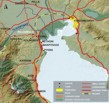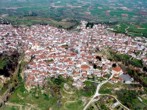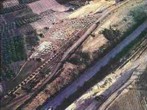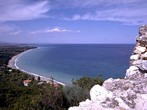|
|
| |
| Pieria |
| Paliambela is a small village in the Prefecture of Pieria , in the south-western part of Central Macedonia . The Prefecture of Pieria is bordered by Mount Olympus and Mount Pieria to the south, the Aliakmonas River to the north, and the Thermaic Gulf to the east. To the west, there is no physical boundary with the Prefecture of Imathia . Pieria is on the national motorway that links Athens to Thessaloniki and then continues to the neighbouring countries of Albania , F.Y.R.O.M. and Bulgaria. |
 In addition, it is not far from the Egnatia motorway, which will connect the Adriatic Sea to Istanbul, and is scheduled to be completed in 2006. The conurbation of Thessaloniki is about 40 km north of the Aliakmonas River. The Prefecture of Pieria is 1,516 square km in size, and has a population of 129,846 inhabitants (2001 census). The capital of the prefecture is Katerini, which has 50,510 inhabitants. In addition, it is not far from the Egnatia motorway, which will connect the Adriatic Sea to Istanbul, and is scheduled to be completed in 2006. The conurbation of Thessaloniki is about 40 km north of the Aliakmonas River. The Prefecture of Pieria is 1,516 square km in size, and has a population of 129,846 inhabitants (2001 census). The capital of the prefecture is Katerini, which has 50,510 inhabitants. |
| |
| History of the area |
| Although the area has been continuously inhabited since prehistoric times, its present state is actually due to the changes that occurred in the first half of the twentieth century. The countryside was sparsely inhabited until 1912, which saw the end of Ottoman rule in the area. Pieria as a whole had just 30,166 inhabitants in 1913, while the biggest town of the area, Katerini, had 7,393. The arrival in Greece of the refugees from Asia Minor after the Treaty of Lausanne in 1923 (about 1,200,000 people at a time when Greece had a population of 5,500,000) brought a large number of newcomers into Pieria area, and more generally to Greek Macedonia. This is reflected in the population growth: in 1920 Pieria had 31,696 inhabitants, whereas in 1928 this had risen to 49,666. The settlement of the refugees necessitated land reform: small farming businesses were created by means of the subdivision and reallocation of land that previously belonged to large agricultural estates. In the course of this development, new villages were founded with the support of the state during the twenties and thirties, and new housing areas were added to old ones. In Pieria alone various settlements saw population increases amounting up to 437% according to the censuses of 1920 and 1928. This was the case at Paliambela itself, and also at nearby Eginio (852 inhabitants in 1920 and 2,556 in 1928). |
| |
| Local administration |
The archaeological site of Paliambela lies next to the small village of the same name. Paliambela village has 266 inhabitants, and lies between the towns of Eginio and Kolindros (about 3-4 km from each). It forms part of the Municipality of Kolindros, which comprises the town of the same name (with 3,629 inhabitants) and three more villages (Kastania, Livadi, Ryakia), giving a total of 5,223 inhabitants in total (2001 census). Kolindros is a traditional town built on terraces at the foot of the  Pieria mountains, at a height of between 280 and 400 metres. It is just three kilometres away from Paliambela. It is one of the oldest settlements in the area, and bears strongly traditional features. The houses are stone-built on wooden frameworks in the original popular Macedonian architectural style and are arranged one next to the other to create narrow cobbled streets. Among these buildings the mansions, churches and schools stand out, which bear witness to prosperous times in the past. To the sights of the area remains of the Byzantine castle dating to the eleventh century AD, the scenic pathway and the Pafsilipos Municipal park must also be mentioned. Pieria mountains, at a height of between 280 and 400 metres. It is just three kilometres away from Paliambela. It is one of the oldest settlements in the area, and bears strongly traditional features. The houses are stone-built on wooden frameworks in the original popular Macedonian architectural style and are arranged one next to the other to create narrow cobbled streets. Among these buildings the mansions, churches and schools stand out, which bear witness to prosperous times in the past. To the sights of the area remains of the Byzantine castle dating to the eleventh century AD, the scenic pathway and the Pafsilipos Municipal park must also be mentioned. |
| |
| Places of archaeological interest |
 Central Macedonia is rich with archaeological finds, and Paliambela is placed within a triangle formed by three very important sites: the ancient city of Dion, in the same prefecture (50 km away), the Royal Macedonian tombs at Vergina and ancient Eges, in the neighbouring Prefecture of Imathia (17 km away), and the Hellenistic city of Pella, in the Prefecture of Pella (50 km away). In Pieria itself there are a number of places of archaeological and historic interest, as the area bears traces of inhabitation dating from the end of the 7th millennium BC. At Korinos, Makrygialos and Pydna, archaeological deposits dating from the Neolithic to the Hellenistic period were uncovered, while at Kolindros, Eginio and Platamonas Byzantine monuments have been preserved. Central Macedonia is rich with archaeological finds, and Paliambela is placed within a triangle formed by three very important sites: the ancient city of Dion, in the same prefecture (50 km away), the Royal Macedonian tombs at Vergina and ancient Eges, in the neighbouring Prefecture of Imathia (17 km away), and the Hellenistic city of Pella, in the Prefecture of Pella (50 km away). In Pieria itself there are a number of places of archaeological and historic interest, as the area bears traces of inhabitation dating from the end of the 7th millennium BC. At Korinos, Makrygialos and Pydna, archaeological deposits dating from the Neolithic to the Hellenistic period were uncovered, while at Kolindros, Eginio and Platamonas Byzantine monuments have been preserved. |
| |
| Tourist attractions |
 The Prefecture of Pieria includes the coastal zone of the eastern shores of the Thermaic Gulf , and no part of the prefecture is more than 40 km from the sea. The area is characterised by clear waters, beautiful beaches and lush green. Holiday resorts, small seaside fishing villages and traditional hillside hamlets are to be found in the area, which accommodates many visitors each year. In fact, Pieria is the second most popular tourist destination after Chalkidiki. Archaeological tours have come onto the scene over the last fifteen years. The excavation of the Royal Macedonian tombs at Vergina in the seventies and the recommencement of the archaeological fieldwork at the ancient city of Dion in 1973 made these places a destination for both foreign and local visitors. Last but not least, there are places of great natural beauty. The mountainous region of Olympus has been made into a national park, while the Aliakmonas estuary and the Kitros salt lakes have been declared protected areas under the Ramsar Treaty. To these a mosaic of cultural activities must be added (such as the "Cultural August", the Eginio annual trade fair), as well as the plethora of small artists' workshops, such as the workshop of the well-known sculptor E. Kalevras in Katahas, five kilometres from Kolindros. The Prefecture of Pieria includes the coastal zone of the eastern shores of the Thermaic Gulf , and no part of the prefecture is more than 40 km from the sea. The area is characterised by clear waters, beautiful beaches and lush green. Holiday resorts, small seaside fishing villages and traditional hillside hamlets are to be found in the area, which accommodates many visitors each year. In fact, Pieria is the second most popular tourist destination after Chalkidiki. Archaeological tours have come onto the scene over the last fifteen years. The excavation of the Royal Macedonian tombs at Vergina in the seventies and the recommencement of the archaeological fieldwork at the ancient city of Dion in 1973 made these places a destination for both foreign and local visitors. Last but not least, there are places of great natural beauty. The mountainous region of Olympus has been made into a national park, while the Aliakmonas estuary and the Kitros salt lakes have been declared protected areas under the Ramsar Treaty. To these a mosaic of cultural activities must be added (such as the "Cultural August", the Eginio annual trade fair), as well as the plethora of small artists' workshops, such as the workshop of the well-known sculptor E. Kalevras in Katahas, five kilometres from Kolindros. |
|
|





